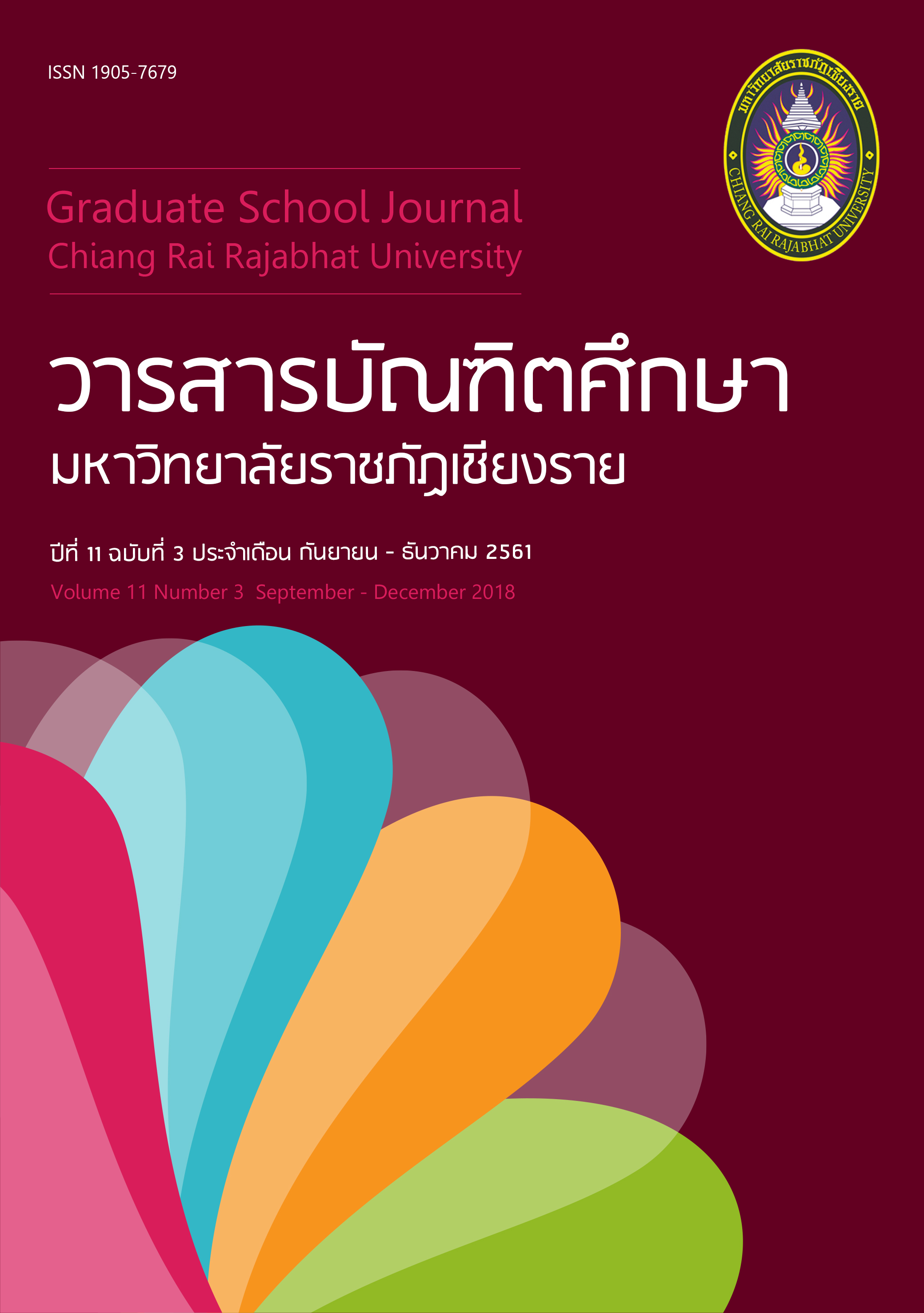บุพปัจจัยที่มีอิทธิพลต่อผลการดำเนินงานของสำนักงานบัญชีในประเทศไทย
Main Article Content
บทคัดย่อ
การวิจัยครั้งนี้มีวัตถุประสงค์ 1) เพื่อศึกษาความสัมพันธ์เชิงสาเหตุของปัจจัยที่มีอิทธิพลต่อผล การดำเนินงานของสำนักงานบัญชีในประเทศไทย และ 2) เพื่อตรวจสอบความสอดคล้องของรูปแบบความสัมพันธ์เชิงสาเหตุ กลุ่มตัวอย่างที่ใช้ในการวิจัย คือ หัวหน้าสำนักงานบัญชีจำนวน 425 คน ได้มาจาก การสุ่มตัวอย่างแบบเป็นระบบ เครื่องมือที่ใช้ในการวิจัยเป็นแบบสอบถาม สถิติที่ใช้ในการวิจัย คือ ค่าร้อยละ ค่าเฉลี่ย ส่วนเบี่ยงเบนมาตรฐาน และการวิเคราะห์รูปแบบความสัมพันธ์เชิงโครงสร้าง
ผลการวิจัยพบว่า ปัจจัยแฝงที่มีอิทธิพลต่อผลการดำเนินงานของสำนักงานบัญชี จำนวน 4 ตัวแปร ได้แก่ ตัวแปรภาวะผู้นำแบบแลกเปลี่ยน ตัวแปรภาวะผู้นำการเปลี่ยนแปลง ตัวแปรองค์การแห่งการเรียนรู้ และตัวแปรการจัดการคุณภาพ โดยปัจจัยที่มีอิทธิพลทางตรงต่อผลการดำเนินงานของสำนักงานบัญชีสูงที่สุด คือ ปัจจัยด้านการจัดการคุณภาพ ส่วนปัจจัยที่มีอิทธิพลทางอ้อมสูงที่สุด คือ ปัจจัยองค์การแห่งการเรียนรู้ ปัจจัยที่มีอิทธิพลรวมสูงที่สุด คือ ปัจจัยการจัดการคุณภาพ และผลการตรวจสอบความสอดคล้องของรูปแบบความสัมพันธ์เชิงสาเหตุ พบว่า รูปแบบมีความสอดคล้องกลมกลืนกับข้อมูลเชิงประจักษ์โดยมีค่า X2= 218.071, df = 198, X2/df = 1.101, P-value = .156, GFI = .957, CFI = .984, RMSEA = .015 เมื่อพิจารณาค่าสัมประสิทธิ์การพยากรณ์ พบว่า มีค่าระหว่าง .359 ถึง .815 โดยปัจจัยการจัดการคุณภาพมีค่าสัมประสิทธิ์การพยากรณ์มากที่สุด และปัจจัยแฝงแต่ละตัวร่วมกันพยากรณ์รูปแบบความสัมพันธ์เชิงสาเหตุได้ร้อยละ 46.9
Article Details
บทความที่ได้รับการตีพิมพ์เป็นลิขสิทธิ์ของวารสารมหาวิทยาลัยราชภัฎเชียงราย
ข้อความที่ปรากฏในบทความแต่ละเรื่องในวารสารวิชาการเล่มนี้เป็นความคิดเห็นส่วนตัวของผู้เขียนแต่ละท่านไม่เกี่ยวข้องกับมหาวิทยาลัยราชภัฎเชียงราย และคณาจารย์ท่านอื่นๆในมหาวิทยาลัยฯ แต่อย่างใด ความรับผิดชอบองค์ประกอบทั้งหมดของบทความแต่ละเรื่องเป็นของผู้เขียนแต่ละท่าน หากมีความผิดพลาดใดๆ ผู้เขียนแต่ละท่านจะรับผิดชอบบทความของตนเองแต่ผู้เดียว
เอกสารอ้างอิง
นภวรรณ คณานุรักษ์. (2554). บทบาทผู้นำองค์กรที่มีพนักงานวิชาชีพ. วารสารวิชาการมหาวิทยาลัยหอการค้าไทย, 31(1), 123-133.
พัฒนาธุรกิจการค้า, กรม. (2559). สถิติผู้ทำบัญชี. สืบค้นเมื่อ 17 พฤศจิกายน 2559, จาก http://www.dbd.go.th/more_ news.php?cid=549
วสิษฐ์ พรหมบุตร. (2555). คุณลักษณะขององค์การแห่งการเรียนรู้และผลต่อคุณภาพการบริการ : กรณีศึกษาเชิงประจักษ์ของโรงพยาบาลเอกชนในประเทศไทย. (ปริญญานิพนธ์การศึกษาดุษฎีบัณฑิต). มหาวิทยาลัยธุรกิจบัณฑิตย์. กรุงเทพฯ.
Bass, B. M. (1990). From transactional to transformational leadership : Learning to share the vision. Organizational Dynamics, 18(3), 19-31.
Beer, M. (2010). Managing change and transition. Harvard: Harvard Business School.
Bititci, U. S., Carrie, A. S. and McDevitt, L. (1997). Integrated performance measurement systems : A development guide. International Journal of Operations & Production Management, 17(5), 522-534.
Brown, S. P. (1996). A meta-analysis and review of organisational research on job Involvement. Psychological Bulletin, 120(2), 235-255.
Farmer, J. H. and Nolle, J. (1994). Professional service firms and total quality management :A good fit?. International Journal of Service Industry Management, 5(3), 5-13.
Hegazy, M. and Tawfik, M. (2015). Performance measurement systems in auditing firms : Challenges and other behavioral aspects. Journal of Accounting in
Emerging Economies, 5(4), 395-423.
Honarpour, A. and Asadi, A. (2012). TQM and organizational learning : A methodologicalperspective. International Journal of Business and Management Tomorrow, 2(9), 1-6.
Hsu, Y. T. (2016). The relationships among transformational leadership, employees’ learning abilities, creativity, and job performance. The Journal of Human Resource and Adult Learning, 12(1), 107-115.
Ignacio, G. V., et al. (2012). Management innovation and leadership : The moderating role of organizational size. Journal of Management Studies, 49(1), 28-51.
Jyoti, J. and Dev, M. (2015). The impact of transformational leadership on employee creativity : The role of learning orientation. Journal of Asia Business Studies, 9(1), 78-98.
Kaplan, R. S. and Norton, D. P. (1996). Using the balanced scorecard as a strategic management system. Harvard Business Review, 74(1), 75-85.
Marquardt, M. J. (1996). Building the learning organization. New York: McGraw-Hill.
Nilsson, L., Johnson, M. D. and Gustafsson, A. (2001). The impact of quality practices on customer satisfaction and business results : Product versus service organizations.
Journal of Quality Management, 6(2), 5-27.
Obiwuru, T. C., et al. (2011). Effects of leadership style on organizational performance : A survey of selected small scale enterprises in Ikosiketu Council Development Area of Lagos State, Nigeria. Australian Journal of Business and Management Research, 1(7), 100-111.
Psomas, E. L., Pantouvakis, A. and Kafetzopoulos, D. P. (March 2013). The impact of ISO 9001 effectiveness on the performance of service companies. Managing Service Quality :
An International Journal, 23(2), 149–164.
Rovinelli, R. J. and Hambleton, R. K. (1977). On the use of content specialists in the assessment of criterion-referenced test item validity. Tijdschrift voor Onderwijsresearch, 2(2), 49-60.
Suliyanto, R. (January 2012). The role of market orientation and learning orientation in improving innovativeness and performance of small and medium enterprises.Asian Social Science, 8(1), 134-145.
Tauber, D. B. (2012). Transformational leadership : Exploring its functionality. (Dissertation). University of St. Gallen. Munich.


